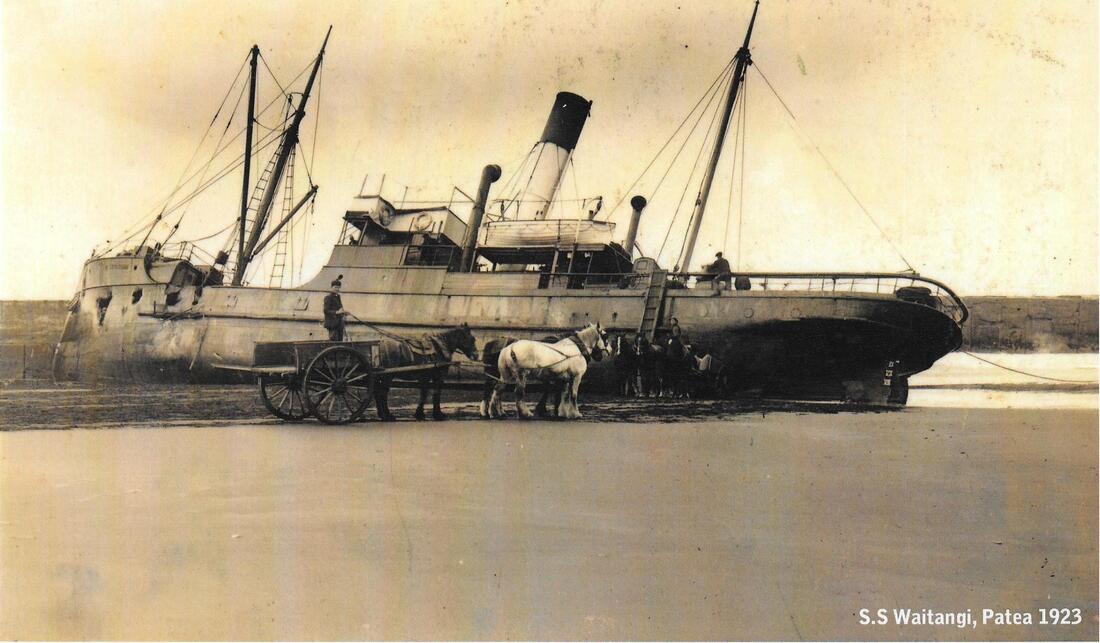The steamer SS Waitangi was built at Grangemouth Dock, England in 1889, and was originally named 'Banks Peninsula', but the name changed to 'Waitangi' in 1896. The ship was bought by the Pātea Farmers Freezing Company in early 1919. SS Waitangi was a 171-ton steel twin-screw steamer, 120 ft, long and 20 ft wide. Before she came to Pātea she had been engaged by the Kauri Timber Co. as a tug for hauling rafts. The passenger accommodation was removed, and the vessel was insulated in preparation for its new cargo of frozen meat. She traded between Wellington and Patea, assisting the SS Waverley also owned by the Patea Freezing Company. On outward voyages the steamer’s cargo would be frozen carcases, and inward would be goods for local business.
Just before midday on 5 May 1923 the SS Waitangi made her final voyage into the Pātea River mouth with a cargo of 46 ton of chaff for the Pātea Farmers Co-op. Captain W Brigden was in control of the vessel until it struck the end of the Western Breakwater, ripping holes in the starboard side and went aground on the Western Beach. All crew escaped unharmed, and the cargo was retrieved undamaged. Efforts were made to salvage her, holes were patched, and the SS Waverley towed her out to sea on a high tide but it didn’t go to plan. The tow cable had to be cut leaving the SS Waitangi to drift back onto the beach where she originally wreaked, and where the remains can still be seen today. Insurance of £3000 was paid to the Pātea Freezing Co. Parts of the vessel were salvaged over the years. The masts became the gate posts at the main entrance to the Pātea Freezing Works for decades. A remnant of one of these posts is now the Donation Box at our museum – Aotea Utanganui. The steam powered Whistle was taken from the wreck and used by the Freezing Works to signal lunch break and the end of the working day. When the Works closed it was retrieved by an employee and is now cared for by his son Rocky Adams.
In recent years the sand has blown off the wreak and it can be seen on the beach beyond this sign, at high tide mark.
Just before midday on 5 May 1923 the SS Waitangi made her final voyage into the Pātea River mouth with a cargo of 46 ton of chaff for the Pātea Farmers Co-op. Captain W Brigden was in control of the vessel until it struck the end of the Western Breakwater, ripping holes in the starboard side and went aground on the Western Beach. All crew escaped unharmed, and the cargo was retrieved undamaged. Efforts were made to salvage her, holes were patched, and the SS Waverley towed her out to sea on a high tide but it didn’t go to plan. The tow cable had to be cut leaving the SS Waitangi to drift back onto the beach where she originally wreaked, and where the remains can still be seen today. Insurance of £3000 was paid to the Pātea Freezing Co. Parts of the vessel were salvaged over the years. The masts became the gate posts at the main entrance to the Pātea Freezing Works for decades. A remnant of one of these posts is now the Donation Box at our museum – Aotea Utanganui. The steam powered Whistle was taken from the wreck and used by the Freezing Works to signal lunch break and the end of the working day. When the Works closed it was retrieved by an employee and is now cared for by his son Rocky Adams.
In recent years the sand has blown off the wreak and it can be seen on the beach beyond this sign, at high tide mark.


